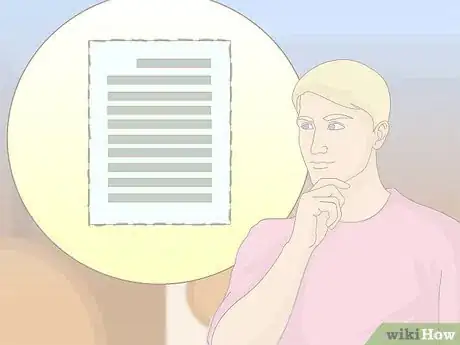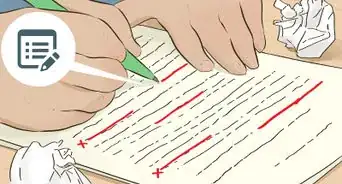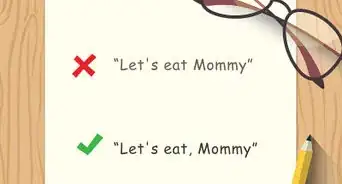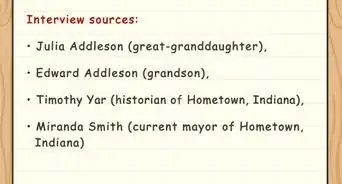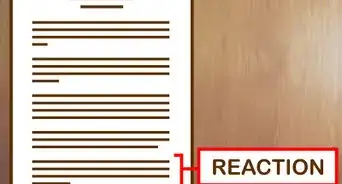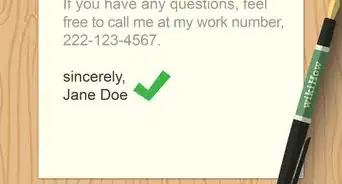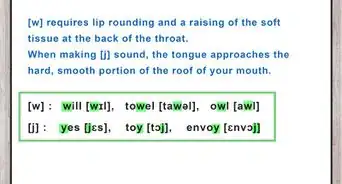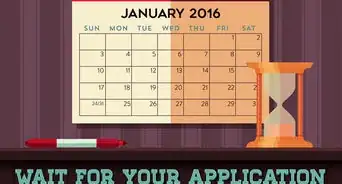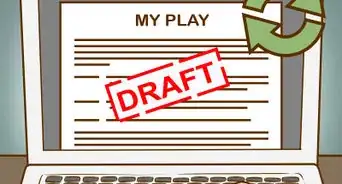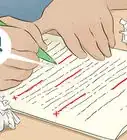This article was co-authored by Stephanie Wong Ken, MFA. Stephanie Wong Ken is a writer based in Canada. Stephanie's writing has appeared in Joyland, Catapult, Pithead Chapel, Cosmonaut's Avenue, and other publications. She holds an MFA in Fiction and Creative Writing from Portland State University.
This article has been viewed 60,882 times.
Most universities will require writing samples as part of the application process, especially if you are applying for a writing heavy degree like journalism, creative writing, or English. An employer may also ask for a writing sample during the application process for a job, particularly if the position is focused on writing and editing written content or conducting research. Providing writing samples doesn’t have to be a chore or a tedious part of your application, and can be done well with a few simple steps.
Steps
Choosing the Writing Sample
-
1Understand the purpose of a writing sample. Your employer or university application reviewer is looking for a writing sample that shows how you organize and express your ideas. Your writing sample should demonstrate to your audience that you can create polished, written material that fits the expectations of the position you are applying for.[1]
- Think of the writing sample as test, or another key element of your application. The employer or university application reviewer will be looking at your writing sample as a way to gauge how you well you might suit the position or the program.
-
2Read the writing sample instructions carefully. The employer may note they are looking for a one page writing sample that shows your ability to communicate a marketing idea effectively. Don’t submit a three page writing sample about the energy crisis, as this will waste the employer’s time and show the employer you don’t know how to follow instructions. The same logic applies to a university application writing sample: only submit samples that respond to the instructions provided by the university. Often, the reviewer will note how well you followed the writing sample instructions and if you provided a sample that matches the criteria specified by the employer or the university.[2]
- Some employers may not specify what they are looking for in a writing sample. If this is the case, consider the position or program you are applying for and how you can demonstrate your skills through a particular piece of writing.
Advertisement -
3Choose the stronger writing sample. When deciding which writing sample to use, it would be ideal if the sample is relevant to the position or program you are applying for and is also your strongest piece of writing. However, this is not always the case. If you are wavering between two samples, one of which is stronger in terms of writing but weaker in terms of relevance, submit the paper that has stronger writing. Your writing sample show demonstrate your writing at its best, and relevancy will come second to a well written sample.[3]
- If you have time, you can also revise the more relevant paper so it is better written and submit it instead. This would show the reviewer you took the time to find an applicable writing sample that also shows off your strong writing skills.
- You could also create a writing sample for a particular job application or university application. This might be necessary if you have limited work experience and are applying for an entry-level job. For example, if you are applying for a job in sales, you might create a mock proposal for a sale of the company’s product to a client, or create a profile for a client. Or if you applying for a research position, you may submit a school assignment that demonstrates your excellent research and writing skills. School assignments are good writing samples for first time applications, especially if you worked hard on them and if they seem relevant to the position or program you are applying for.[4]
-
4Don’t include informal writing samples. Though your writing sample should demonstrate your writing style and voice, don’t use samples that use informal language and a casual tone. Your writing sample should appear professional and polished. Avoid submitting blog posts or Facebook posts as writing samples, unless the blog is a professional blog and addresses issues that relate to your application.[5]
- Always submit recent or current writing over old writing. If you’ve been out of school for several years, your old science term paper may not be the best demonstration of your writing. It will tell the employer or reviewer that you haven’t written in a long period of time and may not showcase your strongest writing.
-
5Go for short, polished samples. The employer or reviewer will likely note how many pages or excerpts they want in the application. If there is no specified number, avoid submitting a ten page essay or a fifty page report, as most reviewers have limited time and will likely not be willing to read more than a few pages of your writing sample. The standard page count is around two to five pages for university writing samples. Some employers may only ask for a one to two page writing sample.[6]
- If you have a long paper that you would like to submit, choose excerpts from the paper that showcase your best writing. One option is the choose a section from the introduction, the body paragraphs, and the conclusion, totalling no more than five pages, so your reader has a sense of the paper as whole.[7]
Formatting the Writing Sample
-
1Check for grammatical and spelling errors. Give your writing sample a close read for any errors, as you want your sample to appear well written and as perfect as possible. This is relevant even if you are applying for a job that does not necessarily require in depth writing every day, as you will likely be emailing clients and your employer will not want error riddled emails being sent out under the company letterhead.[8]
- One trick is to read your writing sample backwards to look for any misspelled words or grammatical mistakes. You can also ask a peer, friend, or colleague to read over your writing sample for any obvious spelling and grammar errors you may have missed.
-
2Follow any formatting guidelines specified in the application. Many applications will include a formatting guide or a short paragraph describing how they would like to receive the sample. This could be: double spaced, with page numbers on the bottom right corner and your name clearly stated on the front of the sample.
- If the formatting is not specified, it’s always best to make the sample double spaced so it is easy to read and to include page numbers and your name.
- If you are submitting an excerpt, you should include a note that informs the reader is is an excerpt from X page to X page, and provide the topic of the paper on the top of the sample.
-
3Remove any confidential information in the sample. If you are using a writing sample from a document you created for a previous position, be sure to mask any real names, descriptions, or numbers so you don’t reveal private information. Avoid exposing your previous employer by taking the time to hide or remove any confidential information in your writing sample, as they are likely not essential to the sample.[9]
- Another option is to create a fake company name and adjust the location and type of business noted in the sample so you don’t reveal any private details.
-
4Create a table of contents. This is especially important if you are submitting a writing sample for a university application, as it shows you took the time to organize and format your application. Include your writing sample in the Table of Contents so it is easy for the reviewer to access.
Community Q&A
-
QuestionIs it okay to use a quote as a reference in a writing sample for job?
 Community AnswerAs long as you properly attribute the quote, that's fine, just make sure you don't include too many. You want your writing sample to be original, not something cobbled together out of other people's words.
Community AnswerAs long as you properly attribute the quote, that's fine, just make sure you don't include too many. You want your writing sample to be original, not something cobbled together out of other people's words.
References
- ↑ http://www.careereducation.columbia.edu/node/2120
- ↑ https://www.psychologytoday.com/blog/career-transitions/200906/the-dreaded-writing-sample
- ↑ http://www.careereducation.columbia.edu/node/2120
- ↑ http://career-advice.monster.com/job-search/getting-started/writing-sample-job-application/article.aspx
- ↑ http://career-advice.monster.com/job-search/getting-started/writing-sample-job-application/article.aspx
- ↑ https://www.psychologytoday.com/blog/career-transitions/200906/the-dreaded-writing-sample
- ↑ http://www.careereducation.columbia.edu/node/2120
- ↑ https://www.psychologytoday.com/blog/career-transitions/200906/the-dreaded-writing-sample
- ↑ http://career-advice.monster.com/job-search/getting-started/writing-sample-job-application/article.aspx
